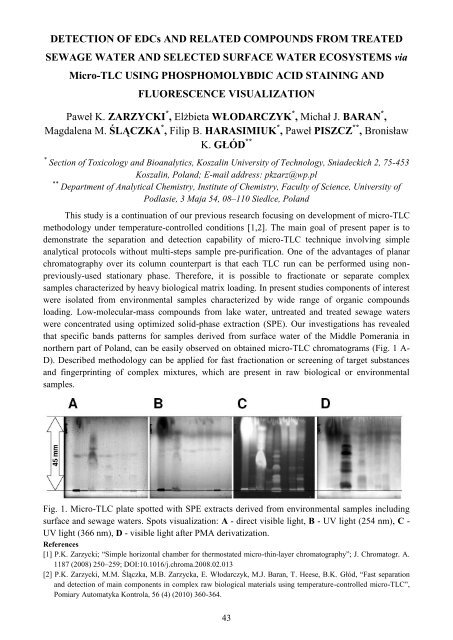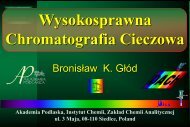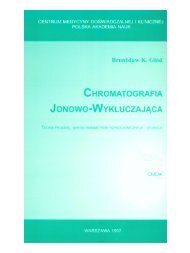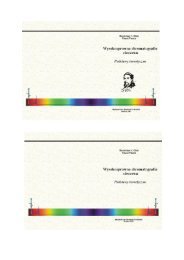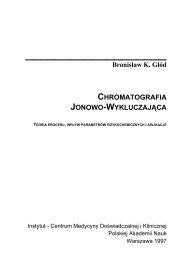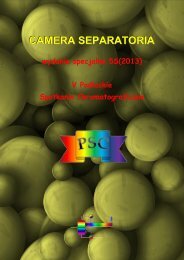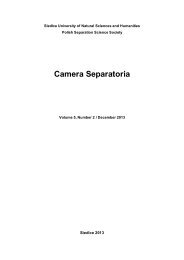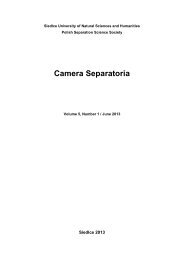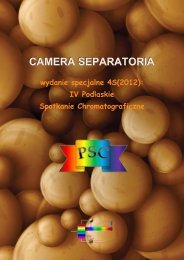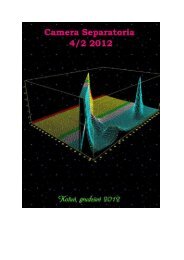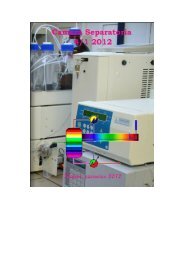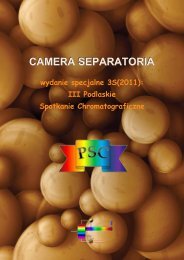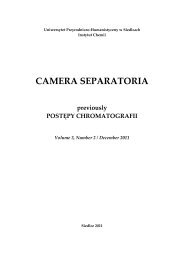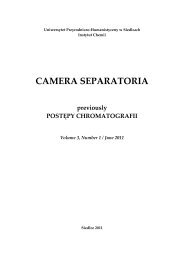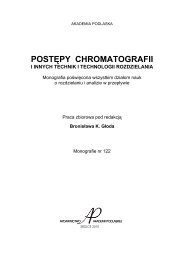CamSep 2 S
You also want an ePaper? Increase the reach of your titles
YUMPU automatically turns print PDFs into web optimized ePapers that Google loves.
DETECTION OF EDCs AND RELATED COMPOUNDS FROM TREATED<br />
SEWAGE WATER AND SELECTED SURFACE WATER ECOSYSTEMS via<br />
Micro-TLC USING PHOSPHOMOLYBDIC ACID STAINING AND<br />
FLUORESCENCE VISUALIZATION<br />
Paweł K. ZARZYCKI * , Elżbieta WŁODARCZYK * , Michał J. BARAN * ,<br />
Magdalena M. ŚLĄCZKA * , Filip B. HARASIMIUK * , Paweł PISZCZ ** , Bronisław<br />
K. GŁÓD **<br />
* Section of Toxicology and Bioanalytics, Koszalin University of Technology, Sniadeckich 2, 75-453<br />
Koszalin, Poland; E-mail address: pkzarz@wp.pl<br />
** Department of Analytical Chemistry, Institute of Chemistry, Faculty of Science, University of<br />
Podlasie, 3 Maja 54, 08–110 Siedlce, Poland<br />
This study is a continuation of our previous research focusing on development of micro-TLC<br />
methodology under temperature-controlled conditions [1,2]. The main goal of present paper is to<br />
demonstrate the separation and detection capability of micro-TLC technique involving simple<br />
analytical protocols without multi-steps sample pre-purification. One of the advantages of planar<br />
chromatography over its column counterpart is that each TLC run can be performed using nonpreviously-used<br />
stationary phase. Therefore, it is possible to fractionate or separate complex<br />
samples characterized by heavy biological matrix loading. In present studies components of interest<br />
were isolated from environmental samples characterized by wide range of organic compounds<br />
loading. Low-molecular-mass compounds from lake water, untreated and treated sewage waters<br />
were concentrated using optimized solid-phase extraction (SPE). Our investigations has revealed<br />
that specific bands patterns for samples derived from surface water of the Middle Pomerania in<br />
northern part of Poland, can be easily observed on obtained micro-TLC chromatograms (Fig. 1 A-<br />
D). Described methodology can be applied for fast fractionation or screening of target substances<br />
and fingerprinting of complex mixtures, which are present in raw biological or environmental<br />
samples.<br />
Fig. 1. Micro-TLC plate spotted with SPE extracts derived from environmental samples including<br />
surface and sewage waters. Spots visualization: A - direct visible light, B - UV light (254 nm), C -<br />
UV light (366 nm), D - visible light after PMA derivatization.<br />
References<br />
[1] P.K. Zarzycki; “Simple horizontal chamber for thermostated micro-thin-layer chromatography”; J. Chromatogr. A.<br />
1187 (2008) 250–259; DOI:10.1016/j.chroma.2008.02.013<br />
[2] P.K. Zarzycki, M.M. Ślączka, M.B. Zarzycka, E. Włodarczyk, M.J. Baran, T. Heese, B.K. Głód, “Fast separation<br />
and detection of main components in complex raw biological materials using temperature-controlled micro-TLC”,<br />
Pomiary Automatyka Kontrola, 56 (4) (2010) 360-364.<br />
43


